6 Awesome Soccer Drills For Beginners | Coaching Basic Soccer Skills
There are thousands upon thousands of soccer drills that you can find online for coaching young soccer players. However, if you happen to coach beginner players who are brand new to the game, finding the appropriate activities for your team can be a real challenge! Below you’ll find a quick guide to coaching beginner soccer players and the skills they should learn, plus our favorite soccer drills for beginners that are guaranteed to turn your group of novice players into lovers of the beautiful game!
What Are The Basic Skills Of Soccer?
Soccer is a dynamic and complex game, but at its core are several very basic soccer skills. The basic skills of soccer are dibbling, turning with the ball, passing and receiving, spatial awareness, shooting, and individual defending. When coaching beginner soccer players, it’s important to include drills and practice exercises that focus on these skills so that your players can progress to the next level.
How To Coach A Beginner Soccer Team
The best way to practice soccer is by playing it! That being said, there are two schools of thought regarding how players should master the fundamental skills of soccer. The first, more traditional route involves teaching skills in isolation. The idea is that players can give complete focus and attention to the skill in which they are trying to develop and learn it at their own pace. Once a particular skill is mastered, the theory is that a player should be ready to take it into the game environment more comfortably.
The second, more modern approach, believes that ‘context is key.’ Proponents of this philosophy believe coaches should include opponents in the vast majority (if not all) of their activities. Doing so encourages decision-making in real-time and ensures players learn how to execute skills and problem solve simultaneously, as is demanded in a real game.
More important than both these philosophies is the need to make practice fun! Players who don’t enjoy coming to practice will soon lose interest and stop playing altogether. So, when coaching beginners, make sure to make practice fun so that your players want to come back to practice week after week. To help you make soccer practice fun, here are our favorite soccer drills for beginners that are not only fun but cover all the basic skills beginner players need to master.
Soccer Drills For Beginners
Drill 1: British Bulldog – Dribbling Skills
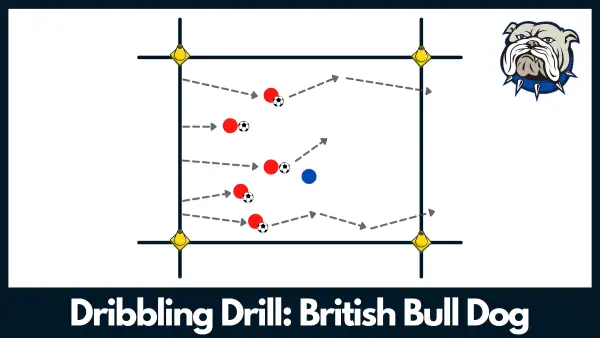
Based on the classic schoolyard tag game, this drill helps players develop dribbling skills with accumulative and increased pressure from defenders. Played without balls, this drill also develops speed, agility, and spatial awareness as players try to avoid the tagger as they run, duke, dodge, and change direction.
To set up the drill, make a 20×25-yard grid and prepare a supply of balls (one for each player). Begin by having all players stand at one side of the grid without balls. Designate one player to start as the “bulldog”. Bring them to the center of the grid and have them face the other players.
Upon the coach’s call, all players must run across the grid without being tagged by the bulldog. Any player that gets tagged becomes another bulldog. If players make it to the other side of the grid without being tagged, they get to go again in the opposite direction (note they should wait for the coach’s call before running back). Repeat the process until all but one player is caught. This player is the winner!
Once you have played one or two times, introduce balls into the game. This is where players get to work on their dribbling skills! Players need to dribble their balls across the grid, with the bulldog trying to kick their balls out as they pass. Any player that loses their ball becomes a bulldog. The last player to lose their ball is the winner!
For coaching points, variations, tips, and to download a PDF of this drill, visit our British Bulldog Drill page.
Drill 2: Ball Hog – Turning With The Ball
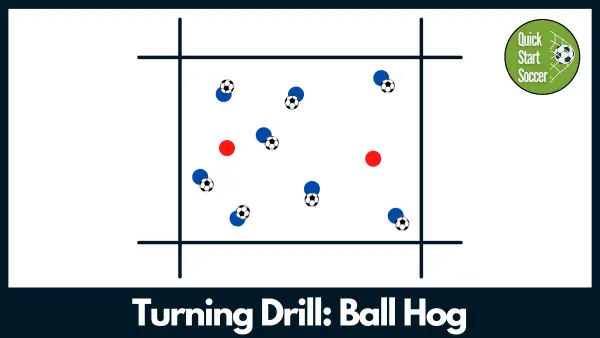
This next drill for beginners is a fun and energetic warm-up game that is great for practicing players’ turning skills while under pressure from opponents. Throughout the drill, you can demonstrate basic turn moves to players, such as the drag back or inside hook.
To set up the drill, make a 20×20-yard grid (or bigger if you have more than 12 players) and have a supply of balls ready. Next, give three quarters of the players a ball each and put them inside the grid. These players are the initial ‘ball hogs’. The rest of the players start outside the grid without a ball.
Upon the coach’s call, the players without a ball run into the grid, try to steal the balls, and maintain possession. If a ball hog loses possession, they can try and steal it back or go after someone else’s ball. If a person kicks the ball out of the grid the person challenging them gets to bring it back in and play continues. After a designated amount of time the coach calls an end to the game. Anyone with a ball at their feet is declared a winner, and all players without a ball have to do a fun forfeit.
For coaching points, variations, and tips, and to download a PDF of this drill, visit our Ball Hog Turning Drill Page.
Drill 3: 3v1 Monkey In The Middle – Passing And Receiving
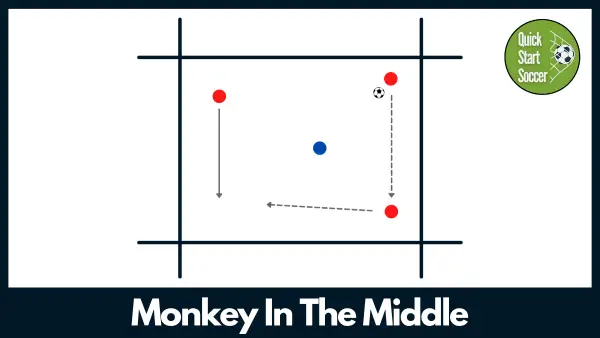
This basic rondo drill is great for beginners to practice their passing and receiving skills. A great way to make this drill more fun while making it easier for the attackers is to have the defending player defend while carrying an additional ball under their shirt.
To set up this drill, first, make a 12×12-yard grid for every four players. Have enough balls for each player, plus some extra balls for quick restarts. Choose one player in each group of 4 to be the ‘monkey in the middle’ and give them a bib to hold.
The aim of the game is simple. The monkey in the middle must try to get the ball while the other three players must keep the ball away from the monkey by passing to each other. If the monkey in the middle wins the ball, or somebody accidentally kicks the ball out, the offending player switches places with the monkey, and play continues.
For coaching points, variations, and tips, and to download a PDF of this drill, visit our Monkey In The Middle Drill Page.
Drill 4: The Four Goal Game – Developing Spacial Awareness
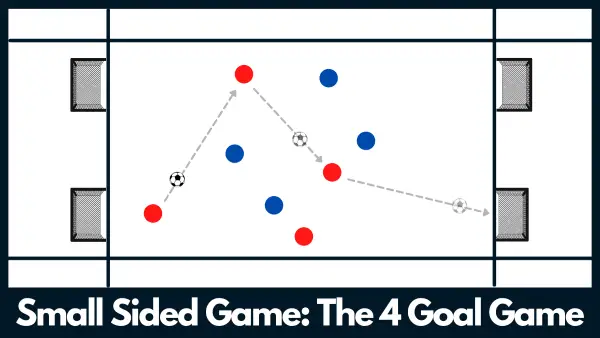
By adding an extra goal on each side of the field, this drill really helps beginners to develop their spatial awareness and helps them to understand the importance of spreading out, keeping their shape, and playing with their heads up. With beginners, the ideal format of this drill is 4v4, so if you have many players, try utilizing subs or playing on multiple fields.
Set up a 25×35-yard grid with two goals at each end, as shown in the diagram. Split the players up into teams of 4 and put them in different colored bibs. You need one ball but have some spare to help facilitate quick restarts.
The two teams compete for possession of the ball. Play is directional, with each team attacking and trying to score in one set of goals while defending the other two. Play kick-ins/dribble-ins from the side with the non-offending team playing the ball back in to restart the game. The team with the most goals at the end of a set period is the winner.
For coaching points, variations, and tips, and to download a PDF of this drill, visit The Four Goal Soccer Drill page.
Drill 5: 2v1 To Goal – Shooting Skills
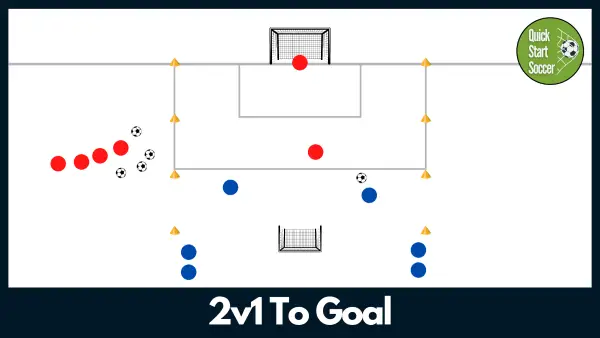
In this simple shooting drill for beginners, players get plenty of shooting repetitions whilst under pressure from an opponent, just like in a real game!
Set up a 30×25-yard grid with a large goal at one side and a small goal at the other. Split the players up into two teams. For the purpose of this description, the teams are red and blue. Have a supply of balls ready with the red team.
The blue team starts as the attacking team and lines up in two lines on either side of the small goal. The red team starts as the defending team. They should put one player in goal with the remaining players lining up at the side of the field as shown in the diagram.
The first player in line for the red team passes the ball to a blue team player at the front of one of the lines (left or right side). The two blues then attack the large goal and try and score. The red player who made the pass defends the large goal and tries to stop them. If the red player wins the ball back, he/she can attack the small goal. Once the ball goes out of play or a goal is scored, the process is repeated with the next players in line. Play for 5 minutes and then switch roles. Whichever team scores the most goals wins.
For coaching points, variations, and tips, and to download a PDF of this drill, visit the 2v1 To Goal Drill Page.
Drill 6: 1v1 Defending – Defending Skills

This 1v1 soccer defending drill is great for beginners as it gives players an incredible amount of repetition as they defend the ball and try to dominate their opponent. The ideal number of players for this activity is six, so set up multiple grids if you must to accommodate all players.
Set up a 12×18-yard grid and set up two small goals diagonally across from each other. Split the players up into two groups and have them line up facing each other to the right-hand side of each goal (see diagram). Have a supply of balls ready for each grid.
Play begins with the first player in line from one team passing the ball to the first player in line from the other team. They compete in a 1v1 duel against each other, trying to score on the goal they are facing. The duel is over after a goal is scored, the ball leaves play, or 60 seconds elapses. Repeat the activity with the next players in line. After 5 minutes of play, alternate the team playing in the original pass. Whichever team scores the most goals overall wins!
For coaching points, variations, and tips, and to download a PDF of this drill, visit our 1v1 Soccer Defending Drill Page.
Wrapping Up
Coaching beginner soccer players, especially if they are completely brand new to the game, can be particularly challenging. Soccer drills for these players should not only teach players the basic skills they need to progress but should also be fun for players so that they continue to come to practice. I hope your players have lots of fun with these drills. Before you go, don’t forget to check out our vast library of free soccer drills for more inspiration for your next coaching session.

